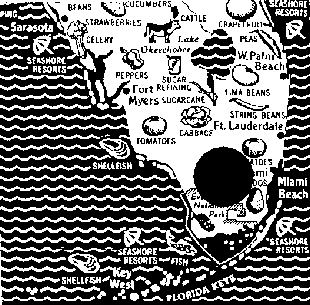 |
Science Frontiers ONLINE No. 43: Jan-Feb 1986 |
|
|
Everglades astrobleme?
Astrobleme means "star wound," and the southern tip of Florida seems to have been wounded by an asteroid or some other celestial projectile. At a recent meeting of the Geological Society of America, E.J. Petuch proposed that the Everglades region received a direct hit from an asteroid about 36 million years ago.
The Everglades region is a swampy, forested area surrounded by an oval-shaped system of ridges. Geologists usually maintain that the Everglades represent a collapse feature caused by groundwater dissolving away limestone. (Buildings and cars seem to be swallowed fairly regularly by Florida sinkholes.) Petuch disagrees with the collapse theory and points to the following evidence for an impact origin:
1. The presence of a strong positive magnetic anomaly; 2. Eocene formations, 40 million years old, are missing over the southern Everglades; 3. A network of fractures pervades rock layers older than Eocene; 4. High iridium concentrations, probably of extraterrestrial origin, exist at the Eocene-Oligocene boundary on nearby Barbados; and 5. The oval reef structure that seems to have grown around the impact area as sealevels rose.
Some geologists do not concur with the asteroid theory, but they are all reviewing Florida's geological history in a new light.
(Weisburd, S.; "Asteroid Origin of the Everglades?" Science News, 128:294, 1985.)
Reference. Very large craters and astroblemes are cataloged in ETC in out catalog: Carolina Bays, Mima Mounds, which is described here.
 | Time, of December 9, 1985, has a nice map of the asteroid's "footprint", but copyright laws prevent us from using it; so we've made our own. The black circle is the collapsed basin surrounding the impact point. The elliptical coral reef is tangent to the southern rim of the collapse basin and runs northwest through the tomatoes, loops around Lake Okeechobee between the peas and lima beans. |